The word imagination shimmers in the mind along with ‘inspiration’ on a higher level than invention, construction or observation. In the Renaissance and earlier consciousness the true artists were the poets. Painters and sculptors suffered under the lesser designation as artisans/craftsmen. Unrecognised as artists because they were simple copyists, therefore without imagination. Vasari and his artist subjects worked hard to change this by equating their efforts with the imagination of the poet. Thanks to their efforts the visual arts now seem to top the charts as far as prices paid for our products are concerned. But there is a down side.
In the arts the word has come to mean working without reference to nature. So the expectation of imagination from the visual arts has inadvertently come to mean fantasy: to out-weigh observation. Whereas what we have actually admired in the past is the vivid observation of nature in which imagination enters as much and as little as in daily life. The patches of light that come to our retina have to be interpreted by the brain, that can only be an act of imagination because they are recognised usually in spite of inadequate data certainly not by perfect matching.
Every act of recognition requires memories and imagination. When I look at the chair beside my bed I see patches of dark brown and lighter brown light. The colour relationships remind me of corduroy and my memory of casting aside my trousers allows me to recognise the patches of light as my trousers but there is no evidence in the shapes I see that these are indeed trousers. It is the memory of light on corduroy that has given the clue to my deduction. Every act of recognition could be described as a discovery because we need imagination for the simplest acts that allow us to find our way in the world. Imagination is not rare it is an everyday necessity.
When Copernicus discovered that the earth was circling the sun he was using his imagination to see the orbits from outer space. That discovery has shaken the world so badly that had he advertised it he would probably have been burnt at the stake. There is a qualitative and a quantitative difference between my finding of my trousers and Copernicus’ vision based on data that was thousands of years old but not recognised. His was the greatest leap of the imagination made by Man. It has reduced our status from the centre of the universe to a tiny speck in a probable multiverse. The human imagination has grown in status based on Copernicus and his like but it is sensible to regard it also as normal and everyday. We need to distinguish between the low flights of recognition and the high flights of imagination.
The significance of a discovery needs to be the measure of its importance. We need to take some of the unreasoned shine from the word. Imagination can be vastly important or everyday insignificant. I fear that art historians have been over impressed by Vasari’s arguments and have illogically reasoned that as Rembrandt is undoubtedly exceptional he must therefore have worked from imagination. Alas. this is hopelessly wide of the mark. Yes, Rembrandt possessed a wonderful imaginative empathy with his subjects but to realize feelings he needed to observed them in reality. The scholars have imposed on a master of huge importance, one who consistently claimed to work from observation “anything else was worthless in his eyes”- a method of work that does not fit at all. To make him fit his new work description scholars have had to discard more than half his genuine works. When Rembrandt is obliged to work by construction, with flying angels for instance, he makes sure that we do not take him seriously; he adopts a looser style (Link to flying angels)
It is indeed surprising that so many scholars have subscribed to the absurd idea of his imaginative construction for so long in the face of so much contrary evidence, and while doing immeasurable harm to our understanding of the master. My article on Rembrandt’s use of mirrors (Burlington Feb.1977) should have dispelled any remaining doubts about the unanimous testimony of Rembrandt’s contemporaries in this respect. Changing entrenched beliefs requires much patience – as Max Plank observed “science advances funeral by funeral”. The damage to Rembrandt and therefore to art continues unabated. At Harvard the only time we came near to debating the issue – I would claim to have won hands down but clearly the scholars took a different view because they have brushed aside my evidence as if it did not exist. There is no evidence for their view other than the fact that many scholars have accepted it unquestioningly for nearly a century! All the evidence favours my interpretation.
In his“Triumph of Art” Part 4 of the TV series Civilizations Simon Schama described Velásquez’ Las Meninas as “a triumph of illusionistic painting”, also, as “a huge brain teaser”. Velasquez himself is “the most cerebral painter of his generation”. Schama asked what is painted on this large canvas we see the back of? possibly the princess or perhaps the king and queen ? “Generation after generation of writers commentators and artists have tried to explain it” but, Schama thinks that “no one has quite got to the bottom of it”. He does not exaggerate the degree to which scholars have found mystery where as a practicing sculptor I have often found a simple, practical explanation for scholars’ mysteries. Of course, it is Las Meninas painted on the front of the huge canvas, self portraits often include the back of the canvas (Las Meninas is approx 3m high). I cannot disagree with his final explanation – the painting is about who is in charge of the way we see but alas my answer is unfortunately the theoreticians, not the painter as Schama implies!
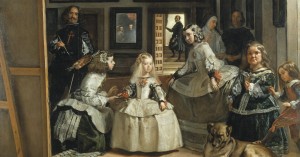
Las Meninas Velasquez
My own inquiry started from the question how did Velasquez actually see what he was painting – obviously he needed a mirror to paint a self-portrait. He could not have seen those standing beside and in front of him without seeing them in the same mirror in which he saw himself; so it must be worth asking the question did he actually use a mirror. It would have had to have been a big one, plate-glass did not exist in 1656 when this picture was painted but there was a hall of mirrors in the royal palace in Toledo which Velasquez was in process of transferring to the new Palace in Madrid at the time he painted Las Meninas. Spain had been receiving tribute from Holland and the mirror we see painted reflecting the king and queen in Las Meninas is in a Dutch frame. The same mirror or an identical one can still be seen in the sacristy of the cathedral in Toledo. We would need two rows of four such mirrors mounted together to cover the figures within the subject matter in the painting. But for a Royal Hall of Mirrors that does not seem an exaggerated possibility. Unfortunately there’s no record of the size of mirrors in the hall but the painting seems to represent the room next door (with minor modifications). When we ask the question did Velasquez actually use a mirror? the answer comes back from the painting itself -YES, eight times. 1. Velasquez changed himself to a righthander, 2. he painted the Infanta in the same year with her parting on the other side of her head. 3 the lighting of the group on the left depends on reflected light from the mirror. Are these not proof enough that he used the mirror I published these ideas in The Artist Magazine in March 1980 but scholars continue to pursue mysteries in painting, clearly miracles are preferred by them to practical explanations.
My straightforward explanation would be useful to artist today who undertake group portraits. It is a technique which I suspect was used by Velasquez’ assistant for his family portrait and by Goya for his royal group, both artists included a self-portrait. But they disguised their method,. Velasquez did nothing to disguise his method. Art scholars think very differently to artists, they prefer written, cerebral evidence to visual clues; and as they have come to dominate the discussion of art in the media and everywhere else, so useful ideas for artists get lost. There seems to be only a one-way traffic between the theoreticians and the practitioners of art. I have offered similar practical explanations for a number of art miracles many of them are on YouTube (see www.nigelkonstam.com). The use of mirrors by Brunelleschi to invent scientific perspective, by Velasquez as above, by Rembrandt to multiply his subject matter and by Vermeer to augment his use of the camera obscura which I believe he used solely to observe unfocused light. Two mirrors crucially helped him to observe light and allowed him to work in a modest sized studio (3m deep). For artists and those who prefer practical explanations to miracles, I strongly recommend my answers to art historical questions.
I can also explain why I believe half the Elgin Marbles are Roman copies. Furthermore, to our surprise the Roman reproductions have been generally preferred to the Greek originals. (see my Elgin Arguments, Also on Youtube
). The extraordinary speed with which the Greeks freed themselves from the previous Egyptian formula which had endured 3000 years can be explained by their use of wax casts from life as the basis of their miraculous transformation in both bronze and stone (see The Bronzes of Riace for bronze and Dionysos for stone). These revelations bring the master works to which they refer down to human scale, examples from which living artists can profit.
I am still looking for a publisher for all this useful information, I have been looking since 1977.
This blog makes a case for starting again with the neglected art of observation, particularly the art of observing human nature. Humanism: how the spirit of Man expresses itself in the physical world. Humanity is the most interesting subject because it concerns us most deeply. It was the prime subject of art for the 40,000 years prior to this passed century. The subject never pales because life moves on and art changes with it.
Unfortunately the writers on art are somewhat outclassed by the artists themselves when it comes to observing. Some artists have spent their lives studying it. The critics protect their self esteem by avoiding this subject matter and concentrating on abstract ideas, where they feel safer.
After 100 years of this bias in public notice it is little wonder that observed art, the art that Everyman can understand, is in steep decline. Through habit we try to take seriously establishment art (Art Bollocks as it is so justly dubbed by the Jackdaw Magazine) but the effort is seldom worth making. Their art is only of interest to the few who are making money out of it. Art matters because seeing and responding to the world about us is essential to our very survival and art is our best educator in this.
Rembrandt scholarship is used as a demonstration of how far the rot has gone. The scholars seem completely out of touch with human feeling. Having spent their lives in company with the greatest artist to observe humanity, they have so undermined his reputation that students can no longer trust him. Observing the results, they must represent the steepest artistic decline in human history. It is no coincidence that the decline dates from the rise of Art History as a political power. Artists have been too lazy or naïve to direct their own evolution. They have left it to the likes of Serota at the Tate and the Rembrandt scholars.
It is going to be very difficult to stop them but that is what must happen. The Jackdaw and the Stuckists have unearthed sufficient evidence to put many of them “away”. This is well worth considering as a tactic. I have shown that the Rembrandt scholars are simply protecting themselves, their tactics of head-in-sand have worked but done immense damage to the cause of art as a result.
In a nut-shell – my article “Rembrandt’s Use of Models and Mirrors” published in the Burlington Magazine (Feb.1977) demonstrated that the hypothetical development of Rembrandt’s style created by generations of Rembrandt scholars, was no longer tenable. The variations in style were due to Rembrandt’s responses to the very different stimuli of reality or the reflection of that reality in a dim polished metal reflector (glass of the necessary size did not exist in Rembrandt’s day). Below I show three illustrations from that article to clarify this point. Many more examples are available (link to www.saveRembrandt.co.uk)
Take this link to see a 5 minute film which shows the same use of mirrors with two of Rembrandt’s paintings: “The Adoration of the Shepherds” in London and in Munich. The London one (observed in a mirror) has been discredited by the “experts” of the Rembrandt Research Project though it passed all tests that The National Gallery put it through. It probably now resides in the basement there.
The briefest perusal of the three catalogues put out by the three main collections of his drawings (The British Museum, The Rijksmuseum and the Boymans of Rotterdam) show that the “experts” are still spending all their time pretending to put dates on drawing according to style – making no attempt whatever to look at the human aspect which was Rembrandt’s chief concern. Their lack of aesthetic discernment pales into insignificance beside their lack of ordinary common sense. Either the authors are too dim for the job we entrust them with, or they badly need psychological help. The same applies to the regiments of Rembrandt scholars elsewhere.
ARE THE NEW FACTS ABOUT REMBRANDT EVER DISCUSSED? IF SO
HOW ARE THEY COUNTERED? WE WOULD LIKE TO HEAR..
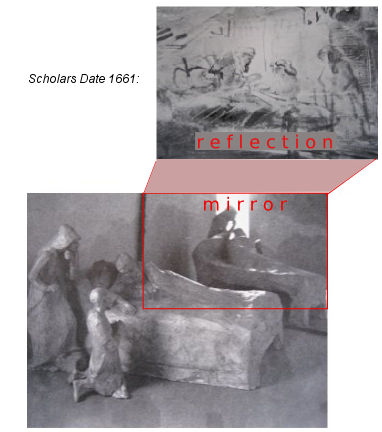 The photo is of a maquette to represent Rembrandt's studio set up with live models and a mirror for his series of drawings of Isaac and Jacob. Below is a drawing that scholars have dated 1652 ( Rembrandt's classical style) and above a drawing they date 1661 (his mature style). The photo demonstrates how both were drawn from the same seat in the studio, under identical lighting conditions and very nearly the same group of models, only Rebeccah has moved. Common sense suggests they were drawn one after the other- not after a gap of 9 years. Clearly the style of the two drawings is very different but the difference can be very well explained by Rembrandt's differing response to reality (below) and reflection in a dim mirror (above). This same difference has been demonstrated many times in Rembrandt's work. eg. The Adoration of the Shepherds, The Dismissal of Hagar and this series of drawings of death bed scenes. Konstam's article “Rembrandt's Use of Models and Mirrors” was published in The Burlington Magazine in February 1977. That article invalidated stylistic criticism but the scholars continue to destroy Rembrandt and waste everybody's time with their out-dated theories. 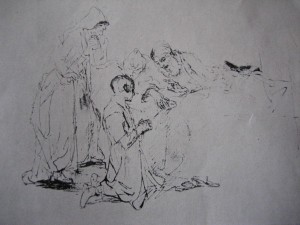 Scholars date 1652 |
|
|
There is one more painting and hundreds more drawings by Rembrandt around in the world than those acknowledged by the experts. They are probably in museums or private collections but may be in the hands of dealers.
On Youtube you can see Konstam’s model reconstruction of the scene in a barn which Rembrandt observed direct from his group of real people to create his painting now in Munich. The camera then pans round to a reflection of that complex model group seen in a mirror of polished pewter (polished copper would have produced a yet more Rembrandtesque warmth of colour). The reflection shows the subject matter of “The Adoration of the Shepherds” now probably in the basement of The National Gallery (London). It was always accepted as a Rembrandt until the Rembrandt Research Project pronounced that it could not possibly be by the same painter as the Munich Rembrandt.
Amusingly only two objects have to be repositioned; the cow and a little boy with a dog. The adults and a central post in the barn with a basket hanging from it remain as they were, even the spaces between them remain constant.
The complexity of the array and the accuracy of its reflection must prove (beyond reasonable doubt) that Konstam’s long scorned version of Rembrandt’s varied output has triumphed over the establishment version that has tried to impose a level of consistency, which is completely at variance with the recorded character of the artist.
Konstam now comes forward with two long forgotten preparatory drawings for the two paintings which he reasonably claims are therefore by Rembrandt, for certain. The first was published as a Rembrandt by W.R.Valentiner in his 1934 catalogue. The second was recognised as a Rembrandt by H de Groot in 1904 but written off by S.Slive in his Dover publication 1965.
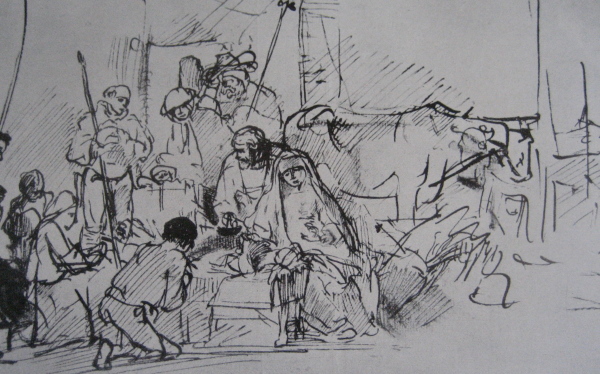
Published as a Rembrandt by W.R.Valentiner in his 1934 catalogue
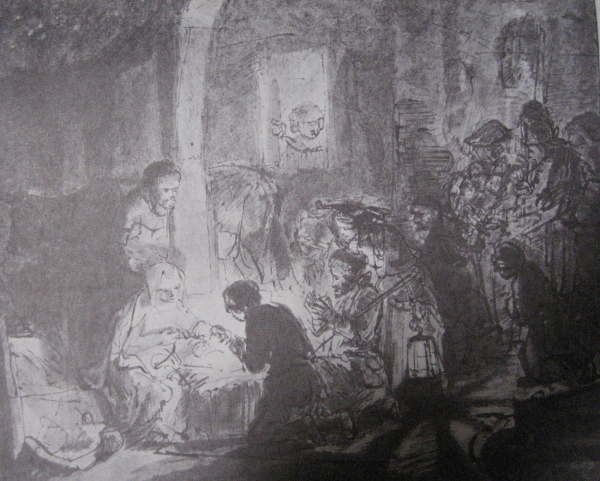
Recognised as a Rembrandt by H de Groot in 1904 but written off by S.Slive in his Dover publication 1965
Konstam points to a particularly beautiful drawn young woman in the drawing wearing a broad brimmed hat and carrying a lantern. The young woman appears again in the National Gallery painting but her hat and lantern are carried by the tall bearded man behind her. This is Konstam’s version of Rembrandt, using live models and mirrors, swapping hats etc.
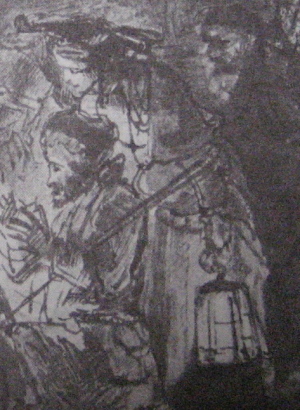 Beautifully drawn woman with hat and lantern |
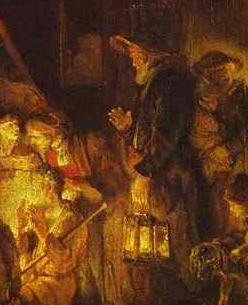 The woman's hat and lantern are carried by the tall bearded man behind her in the National Gallery Adoration |
Over several generations the “experts” have constructed a castle in the air which has finally collapsed because its founded on a series of fallacies. Ninety percent of their judgements from 1904 onwards should be put straight in the waste paper basket. The present scholars should be relegated to pronounce on Warhol and the like. They are fit for nothing else because they are blinkered by their training. It is a sad fact that we see only what we expect to see, in the main.
The aim of this blog is to create a forum of discussion on the present state of art in Britain. Britain seems to be leading the world in the charge of the Gaderine swine.
I am aware of two forums where resistance to “State Art” is strong: the Stuckists and The Jackdaw. But while I salute the splendid spade and foot work both have done in drawing public attention to the gross dishonesty and self-interest of the present regime at the Tate, I feel there is a great need of a third forum where an alternative evolution can be discussed and eventually put in place.
As a former student at Camberwell (1955-7) I look back on that training as a golden age compared to what is available to art students today. I have been revisiting Roger Fry, his Last Lectures, as I regard him as the grandfather of the particular philosophical ambience that distinguished the Camberwell tradition in my time. His influence on Coldstream (head of Camberwell before he went on to the Slade) was crucial to that ambience.
Fry’s insistance on the importance of the abstract or architectonic aspect of a work of art was most apposite to the art of 1900 but I feel that the pendullum of fashion has swung so far in that direction that it is high time to give it a good push towards Humanism. Fry could not have foreseen the depths to which this aspect of his doctrine has sunk: I see the present state of art in Britain as a colossal insult to the intelligence of the majority of us who work or suffer in the dark shadow of the State Art’s massive publicity, so rightly dubbed “Art Bollocks” by The Jackdaw.
Old “Humanism” was the driving force of the Italian Renaissance. It was based on a recognition that Greek art and philosophy had much to teach them about the human condition. I have chosen “New Humanism” as a name in the hope it will bring about a similar renaissance. I mean it to include any art based on observation. The survival of the species depends to a large extent on our ability to see and understand what is going on out there.
Artists tend to be politically naïve or lazy. We have allowed art historians to step in and direct the public face of art, with the result that The Turner Prize, for instance, is only of interest to a favoured few who dominate the public face of art in Britain thereby. I hope this blog will become a forum where alternatives can be intelligently discussed and eventually replace the present horrors. Any ideas?
Please participate and inform your friends.
Yours truly, Nigel Konstam
STOP PRESS A NEW FILMLET ON YOUTUBE
Mirrors used by
Rembrandt for his two paintings of
The Adoration of the Shepherds
ALSO available is Nigel’s 5 minute film on The School of Adrea Verrocchio – Renaissance Sculptor who “restored worth and value to Florentine art at a time when those qualities were on the point of extinction”.
Two quotes from the Phenomenon of Man, (P.Teilhard de Chardin) “Seeing. We might say that the whole of life lies in that verb.”p.31 “a truth once seen, even by a single mind, always ends up by imposing itself on the totality of human consciousness.” p.218
So why is it so difficult to transmit such a truth? I have been at it half a life-time (since 1974 to be precise) and still have not got it through. Thank God for internet, it may give me half a chance. The answer to my question is - because many others think it is their territory and I, a mere sculptor, should not trespass. There is the other complication that what I have seen makes them (the many) look rather foolish for not having seen that truth for themselves. Furthermore that blindness goes back several generations.
I will be aiming at three individuals who made up a team of “experts” in charge of the main collections of Rembrandt’s drawings at The British museum, The Rijksmuseum and the Boymans in Rotterdam. They have produced three new catalogues of their collections which follow the fashion set by The Rembrandt Reseach Project (RRP) of reducing that great master’s corpus by de-attribution, to a mere shadow of it’s former self. The master’s reputation has naturally followed.
I am in the process of writing a commentary on all the drawings I believe to be by Rembrandt and a few which the “many” favour but I do not. I expect the number of Rembrandts in my commentary to be at least twice as large as a catalogue any of these three might be writing (God forbid).
The emphasis in my commentary will be on Humanism and what Fry called “significant form” a term which was the rage while Fry was around but now out of fashion. I call it “visual syntax” by analogy with literary criticism. Today’s “experts” seem hardly aware of syntax yet no real understanding of Rembrandt’s drawings is possible without it. He has a syntax all his own which I will be at pains to make clear in these pages. Very fortunately computer technology has made possible an explanation that was not available to Fry. Some may well still be guessing what he was on about.
The team of Rembrandt experts I am sure are all very cultured in the sense of being well read, knowledgeable about music, poetry and above all about the literature produced by their fellow art historians. But of what we can term visual culture, that is the culture of artists, I do not detect a smattering, scarcely a vestige. No doubt all have been through the Art Historical mill at smart universities and most probably come out near the top of their year because they have thoroughly adsorbed what their professors had to offer, and there lies the trouble. They come through the mill blinkered by the accumulated prejudices of their predecessors. Unable to see for themselves, they chew over and add to the accumulation of half truths. Rembrandt studies are a vicious spiral that has been spiraling downwards for over 100 years. It must be stopped.
No new knowledge is allowed to enter this closed circuit. This particular artist has been banging at their door for half a life-time and has been roundly snubbed and occasionally robbed of his insights. What I have discovered about Rembrandt’s practice would become established fact immediately in scientific circles because of the weight of evidence (see www.saveRembrandt.org.uk). Yet it has hardly penetrated the mentality of Art History beyond the above mentioned thefts. My evidence has been most unsatisfactorily rebutted in The British Museum catalog. Unsatisfactory because there is no mention of the fact that Rembrandt’s use of mirrors has been noted in nearly 100 cases, which statistically must make it a dead cert.
Furthermore, Max Wykes-Joyce wrote of my exhibition at Imperial College (The International Herald Tribune 27.1.76 ) …with the use of maquettes, photographs, mirrors and a text, illustrates what Konstam believes to have been the working methods of Rembrandt, Poussin and others, and which by implication, contradict much of 20th century criticism and scholarship. Certainly as a working artist the case he makes for the re-dating and reconsideration of many of Rembrandt’s drawings is strong.” And later…”certainly the exhibition is a seminal one that should not be lightly dismissed.” The Observer headlined a quarter page article “The Rembrandt Revelation”. Two very eminent art historians (Gombrich and Montagu) assisted me in writing the text that was published in The Burlington (Feb ‘77). The editor (B. Nicholson) wrote in his letter of thanks “ I find the evidence you have accumulated of the greatest possible interest, and so I am sure will Rembrandt scholars, who must now get down to revising the corpus of drawings!” A similar text was published in Dutch (Rembrandthuiskroniek 1978.1) And yet I believe since this auspicious beginning the whole idea has been brushed under the carpet without discussion.
I WOULD BE VERY GLAD TO HEAR FROM ANYONE WHO HAS STUDIED REMBRANDT AT UNIVERSITY LEVEL, WHETHER THIS IS SO.
I named my Art School in Tuscany Italy after the famous ‘School of Verrocchio’ because of my great admiration for the Renaissance Sculptor Andrea Verrocchio who ran the greatest Art school ever known (attended by Leonardo da Vinci, Perugino, Lorenzo di Credi, Domenico Ghirlandaio). Adolf Beyersdorfer in 1876 wrote of Andrea Verrocchio: “Next to his pupil Leonardo, his (Verrocchio’s) is the greatest artistic character that has ever existed. The lofty and strict principles of his studio brought back worth and value to Florentine Art at a time when these qualities were on the point of extinction”.
My 5 minute video about the School of Verrocchio is now available on YouTube
We have recently completed a DVD about one of the all time greats in sculpture. You are unlikely to have ever heard of him. He started his great work as architect and sculptor on Orvieto Cathedral in 1303 and some of the sculpture was in place by 1307 that is some years before Giotto’s Arena Chapel or Duccio’s Maesta. He is so original and advanced technically that he does not fit the mould of art history’s development, so it is easier to leave him out all together!
Technically his work in relief is the missing link between the Pisani (Nicola & Giovanni) and Ghiberti’s “The Gates of Paradise” on The Baptistry in Florence. More importantly he speaks to us through a common humanity more immediately and comprehensively than any of his contemporaries. His observations of humankind are truly delightful. He retells the Bible stories with gravity, humour and even one feels with a touch of criticism for God’s pre-feminist attitude to the fair sex.
How could such a master be neglected? It was in answering this question that I believe I have stumbled upon the great hole in art criticism today. See “A Manifesto for New Humanism” below.
The sculptor’s name is Lorenzo Maitani. You can find splendid photos of his work in “La Facciata del Duomo di Orvieto” (SilvanaEditoiale 2002) or in our DVD see below. If you go to Orvieto take binocculars, the reliefs start at eye-level but go up about 10m, there are 112sq.m of them!
DVD will soon be available through the Orvieto Tourist Board.